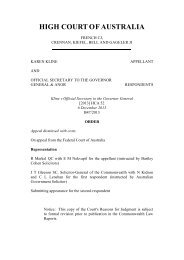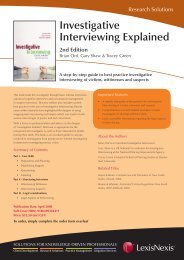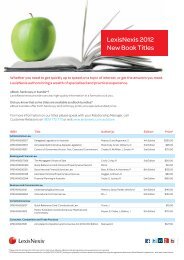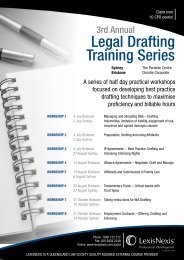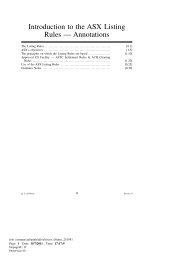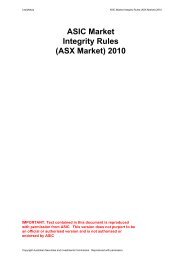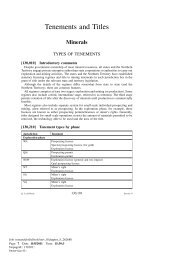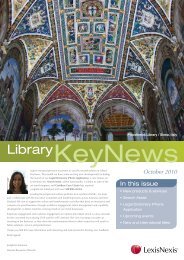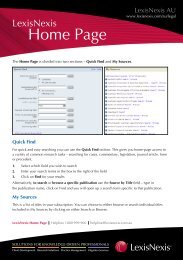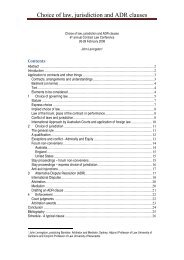Torts: Cases and Commentary - LexisNexis
Torts: Cases and Commentary - LexisNexis
Torts: Cases and Commentary - LexisNexis
Create successful ePaper yourself
Turn your PDF publications into a flip-book with our unique Google optimized e-Paper software.
Amaca Pty Ltd v Ellis; The State of South Australia v Ellis; Millennium<br />
Inorganic Chemicals Ltd v Ellis [2010] HCA 5. Analysing epidemiological<br />
evidence, the High Court held that no inference of causation could be drawn<br />
that the exposure to asbestos was a probably cause of lung cancer when the<br />
plaintiff was also a smoker. Observing that a small percentage of cancer cases<br />
were probably caused by asbestos exposure to asbestos did not permit<br />
identification of whether an individual is one of that group. Given the small<br />
size of the statistical percentage, the observation did not, without more,<br />
support the drawing of an inference in this case. The decision may be<br />
contrasted with Workers Compensation (Dust Diseases) Bord of NSW v Smith<br />
Munro <strong>and</strong> Seymour [2010] NSWCA 19.<br />
Adeels Palace Pty Ltd v Moubarak; Adeels Palace Pty Ltd v Bou Najem [2009]<br />
HCA 48 at *55+: ‘At once it must be recognised that the legal concept of<br />
causation differs from philosophical <strong>and</strong> scientific notions of causation. It<br />
must also be recognised that before the Civil Liability Act <strong>and</strong> equivalent<br />
provisions were enacted, it had been recognised that the "but for" test was<br />
not always a sufficient test of causation. But as s 5D(1) shows, the "but for"<br />
test is now to be (<strong>and</strong> has hitherto been seen to be) a necessary test of<br />
causation in all but the undefined group of exceptional cases contemplated<br />
by s 5D(2).’ {Footnotes omitted}<br />
Woolworths Limited v Strong & Anor [2010] NSWCA 282. Note at [48] the<br />
obiter consideration as to the effect of section 5D(1) Civil Liability Act 2002<br />
(NSW) on the concept of material contribution: ‘*48] Now, apart from the<br />
“exceptional case” that section 5D(2) recognises, section 5D(1) sets out what<br />
must be established to conclude that negligence caused particular harm. That<br />
emerges from the words “comprises the following elements” in the chapeau<br />
to section 5D(1). “Material contribution”, <strong>and</strong> notions of increase in risk, have<br />
no role to play in section 5D(1). It well may be that many actions or omissions<br />
that the common law would have recognised as making a material<br />
contribution to the harm that a plaintiff suffered will fall within section 5D(1),<br />
but that does not alter the fact that the concepts of material contribution<br />
<strong>and</strong> increase in risk have no role to play in deciding whether section 5D(1) is<br />
satisfied in any particular case.’ See however the disagreement of Garling J in<br />
Peter Steven Benic v State of New South Wales [2010] NSWSC 1039 at [516].<br />
11.10 Causation principle legislation<br />
<br />
<br />
Hollier v Sutcliffe [2010] NSWSC 279. Implanon insertion claim, causation<br />
issue as to chronic pain syndrome. Civil Liability Act 2002 (NSW) section 5D(1)<br />
necessary condition test not met: see [212] – [213].<br />
Den Elzen v Harris [2008] WADC 106. Claim concerning management of<br />
hydrocephalus <strong>and</strong> whether outcome would have differed in any event. Note<br />
21



